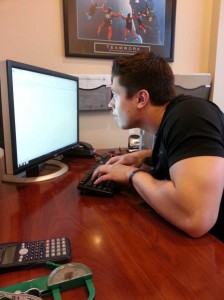Sadly, as we age, we’ll have aches and pains. We often attribute this to getting old, sleeping weird, or doing the wrong kind of exercise. Although all of these may be factors, one big culprit of day-to-day aches and pains is the seated/office posture you’re probably in right now as you read this article.
Think about it — what position are you in the most during your day? Sleeping is the position that you’re in for likely the most sustained period of time, but that’s outside of the scope of this blog. The second most common posture for most of us is our seated office posture, and it’s not good: hunched over back, rounded shoulders, torso leaning forward, wrists hyperflexed, head protruding out towards our monitor, no lumbar support, feet not flat on the ground. All of these “deviations” from proper posture can lead to more than just aches and pains: they can lead to full blown orthopedic issues. Areas often affected by poor seated posture are:
Neck
Shoulder
Upper Back
Lower Back
Hips
Wrist/Hands
Prevention:
Judging by this list, which incorporates nearly 75% of the body, proper seated posture can play a critical role in preventing aches and pains. Here’s some quick office ergonomics tips for treating and preventing posture-related aches and pains:
1.) Lower Your Keyboard Height
Your keyboard should sit more near you lap than sternum or breastbone. Lowering the height of your keyboard will force your wrist to align in a more natural (or neutral) position. This will help to treat and prevent incidents of carpal tunnel syndrome, wrist tendonitis, and tennis elbow.
2.) Sit Closer to Your Desk
Sitting closer will allow your torso to align in a more upright fashion. Your shoulders will sit back further, your shoulder blades will come together, and your lumbar spine will align in more of a natural curve. This will help prevent and alleviate issues in the lower back, upper back, neck, and shoulders.
3.) Lumbar Support
If you follow the first two recommendations, you’ll also want to be sure your chair is correct for you. Two things you should never go cheap on (with regard to posture) is your bed and your desk chair, since you’re in them so much. Your chair should do more than look good. Ideally it should have adjustable arm rests for proper upper body posture. Additionally, the chair should have the right amount of lumbar (lower back) support to reduce compressive stress on the lumbar spine (the area of the back that is most susceptible to injury).
4.) Keep BOTH Feet Flat on the Ground
Avoiding a crossed-leg or one-foot-on-the-ground posture is critical to providing a good base of support for the rest of the body. Doing so will reduce compressive stress on the lower back and also allow for proper hip alignment. For people who are a little shorter, using a footrest that allows your feet to sit flat on the ground can help tremendously. Keeping both feet flat on the ground can prevent lower back and hip pain.
Get Up and Move
Okay, this isn’t so much an ergonomics tip, but the more you get up and move during your work day, the better. Try to avoid sitting for hours on end without getting up. Even if every hour you get up and take a one minute walk, at least you’ve realigned your body and started to drive some blood flow to inactive areas (which will be most of the body). This can help break the cycle of poor posture and lack of circulation that can lead to aches and pains.
Final Thoughts
Implementing all of these suggestions would be great, but even one or two will help. You should realize that initially some of these changes may be difficult. Since seated/office posture is a position we’re very used to being in, the motor skills we do from these positions (typing for example) are very proficient. You may not like your new keyboard height or chair proximity for the first day, or even the first week, but give it time and not only will you get used to it, but you’ll feel better because you’ve put your body in a more natural position.

